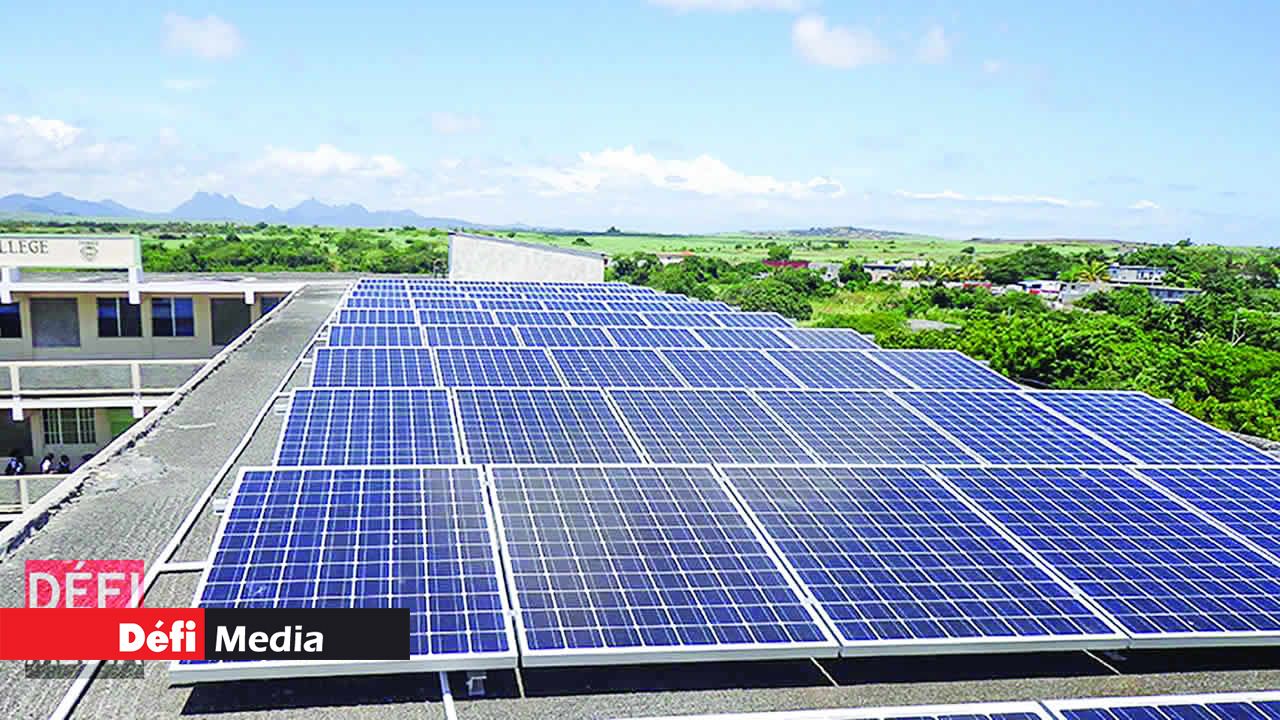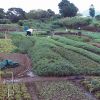
Former United Nations Secretary-General Ban Ki-moon once stated that renewable energy has the ability to lift the poorest nations to new levels of prosperity. European countries have already started benefiting. In Mauritius, we have been hearing a tremendous lot about this concept and some projects have already been set up. But where have we reached? Are we going in the right direction? Or is there still a long way to go? Experts answer these pertinent questions.
Publicité
According to International Energy Agency (IEA), growth in consumption of coal and oil could end by 2022. Similarly, another projection by the IEA, solar power generators may produce most of the world's electricity within 50 years, reducing the emissions of greenhouse gases that harm the environment.
International renowned senior analyst at the IEA, Cedric Philibert, stated that “Photovoltaic and solar-thermal plants may meet most of the world's demand for electricity by 2060 – and half of all energy needs – with wind, hydropower and biomass plants supplying much of the remaining generation."
The acting director of Central Electricity Board (CEB), Shamshir Mukoon, and the Chief Operating Officer (COO) of Leal Energie Ltd, Prakash Ramiah, explain the concept of renewable energy in Mauritius and what is our status.
Electricity consumption
According to Statistics Mauritius, the demand for electricity increases every year. Total energy consumption from 2015 to 2016 only increased by 4% from 912,857 to 951,072. The peak power demand in 2016 reached 468 MW for Mauritius. Similarly, the demand forecast for Mauritius, as stipulated in the Integrated Electricity Plan 2013-2022, the upward trend in the sale of electricity was further maintained during the years 2000.
“It was mainly the result of a re-engineering of the economy accompanied by bolstering strategies in the Hospitality, Commercial and Manufacturing sectors. Over the recent years, the Commercial sector has taken the lead in the share of total electricity sales in Mauritius. The share has grown from 27% in the year 2000 to reach 36% in 2011,” he declares. The Integrated Electricity Plan 2013-2022 clearly mentions that the demand for electricity will grow by an average of 3.43% (compounded growth) annually for the period 2011–2022.

Current status in Mauritius
Shamshir Mukoon explains that renewable energy is very different from conventional energy. “Conventional energy consists mainly of fossil fuels and coals which, with time, can disappear. But this is not the case with renewable energy such as wind, sun and bio mass. They will keep on regenerating. Today, renewable energy is very important. There will come a time when petrol will disappear completely. What will happen to our industries that need energy? We need renewable energy for our development and to produce electricity.”
As highlighted by Shamshir Mukoon, Mauritius consumes around 475 Megawatts in power and our country needs to produce 2,800 GWH. The proportions of energy source are as follows:
- Coal: 40%
- Petrol: 40%
- Biogases: 14%
- Hydro: 4%
- Solar, Eolienne, Sun: 2%
Shamshir Mukoon believes that we are still very far from being a renewable country in terms of energy and it will take time for us to be more independent. This is the reason why the CEB has been encouraging people to set photovoltaic system on their roofs, as they can produce more than 50% of their electricity needs if their total consumption per month is around 200 units.
Prakash Ramiah, who is also a council member of the Association of Mauritian Manufacturers, responsible for the Renewable Energy Committee, argues that the renewable energy share is growing slowly but surely in the national energy mix.
“It could easily have grown at a quicker pace. Besides solar roof-top photovoltaic projects under new Small Scale Distributed Generation (SSDG) Scheme of 5 MW on the grid, several renewable energy projects were connected to the CEB network, including the 9.35 MW wind-farms at Plaines des Roches that will make the renewable energy share exceeds over 19% this year.”
Investment
According to Shamshir Mukoon, 100MGW is costing Mauritius five billion rupees and these investments have already been made. Along the same lines, in January 2017, Mauritius obtained a concessional loan to the tune of Rs 350 million (USD 10 million) from the Abu Dhabi Fund for Development (ADFD), the leading national entity for development aid, and the International Renewable Energy Agency (IRENA), the global platform for international cooperation on renewable energy, for the implementation of solar photovoltaic (PV) projects.
In Mauritius, the ADFD loan of USD 10 million will help the Central Electricity Board install solar PV systems on rooftops of 10,000 households as part of the government’s efforts to alleviate poverty whilst contributing to the national target of achieving 35% of renewable electricity in the energy mix by 2025. An estimated 35,000 people in low income communities will benefit from significant electricity bill savings.
The project will bring 10 megawatts of new renewable energy capacity online, resulting in savings of over USD 35 million in fossil fuel imports over the project lifetime and improvements in the energy security of the country.
Furthermore, concerning investment, Prakash Ramiah believes that Small Island Developing States (SIDs) like Mauritius, with its neighbouring islands, should reduce its dependencies on fossil fuel and encourage distributed clean energy generation through roof-top solar PV, rain-water harvesting and recycle waste water for cleaning and washing at all levels.
“This alone will allow every Mauritian to save fuel, earn a valuable reward through their savings in their electricity bill and by so doing, increase their own revenues.Roof top PV on all public, private and industrial sector buildings should be encouraged across the island with distributed generation across the national utility network. Floating PV on reservoirs should be allowed to reduce water treatment costs over time. Sea water desalination and waste water recycling with solar energy at cost effective prices for industrial usage/cleaning/washing to reduce scarcity throughout the country annually should be encouraged as easily realisable. All street lightings, handled by the local government authorities and RDA for the motorways should be replaced by solar led lights.”

Energy Efficient
When we talk of electricity, we must obviously refer to being energy efficient. Prakash Ramiah recalls that though the PNEE (Programme National Energy Efficiency) is doing a very good campaign for the industrial and private sectors, being extended to public sector by Ministry of Energy and Public Utilities, a national brainstorming / awareness towards energy and water saving and efficient usage campaign should also be done across the Republic of Mauritius, starting from pre-primary schools to old-age associations levels.
“Efficient Clean Energy Usage should be a national mantra, well-anchored in our DNA. Ban entry or impose high duties on all high energy consuming lights, electric equipment (fridges, ACs, ovens) that encourage waste sorting at source for residential, commercial and industrial biogas generation, and encourage each household and firm to produce at least 50% of its own energy from renewable sources.”
Upcoming projects
CEB Grill Energy Company LTD
The CEB is coming forward with a home solar project with aims at installing 10,000 photovoltaic on the roofs of vulnerable people. “The CEB will install the equipment and give these homes 50 units of electricity for free. The surplus produced will be for the CEB. We will then sell the surplus and use this money for installation and maintenance. These people will not have to pay anything,” says Shamshir Mukoon.
The Home Solar project has been initiated. Ten set ups have been set and will be launched officially soon. “We also have another residential project for those willing to set up the photovoltaic. We help them in their installation, they use the amount they need and we take the remaining from them.”
Battery Storage
In order to store the electricity for further usage, the CEB will be investing in batteries. For example, by the end of July, there will be a battery of 4MGW and in two years, it will be 14MGW.
The CEB acting director explains that the government aims at achieving a target of 35% by 2022 in renewable energy, hence they are optimizing in the best way they could to achieve this target in seven years’ time.
Stations
The CEB is embarking on setting up stations. For example, the CEB is exploiting land and setting up a 2MGW station next year and in one and a half year, will make it 10MGW.
Combined cycle gas turbine plant
A gas turbine is in view at Fort George. The first phase is estimated to end in 2019 and the second phase in 2022. This station will be around 120MGW in electrical power. Initially, it will be run by very little diesel but the CEB is working towards the importation of Liquid Natural Gas, which will take over the operation of this plant. This plant not only aims at providing electricity but will also work towards reducing pollution.
Alteo project
With new technology, Alteo will be using ‘bagasse’ from its old factory to produce more electricity. The project is still in discussion and focus on around 70MGW.
CEB Fibre Net Company Ltd
Another subsidiary of CEB, the CEB Fibre Net Company will be focusing on making the CEB more Smart. The system will be more technology-based, where there will be no meter reader going to places. It will be Smart Grid Network. It is a big investment and it will take some time to be implemented. The network is being upgraded slowly and steadily.
The weaknesses
Despite all its advantages, renewable energy needs to overcome several challenges and weaknesses. The main weaknesses are listed as follows:
Lack of space
Shamshir Mukoon states that photovoltaic system needs much more space and in Mauritius, land is expensive. “The project costs a lot because acquiring a plot of land is costly. This issue can be addressed if we try to exploit lands that are unexploited and deserted.
People can also make the most of used lands that no longer serve to cultivate sugar cane.” He further recalls that for the time being, wind turbine does not have potential, as people complain of the noise from the turbine.
Accordingly, as stipulated by the acting director, research is being undertaken to see if the wind turbines can be set up at the sea but this will take time.
Intermittence
Another issue, as explained by the acting director, is that renewable energy is not stable. “We continuously get electricity because petrol engines are turning permanently. But if we solely rely on PV to light up a bulb, it is an issue. Because if there is no bright sun, there will be no electricity.
The electricity is not stable. We need to stabilize this electricity from renewable energy. With bio mass, we are limited and for water also, we cannot focus on it. We need to have huge batteries.
Expensive installation
Another challenge is expensive installation fee. As highlighted by Shamshir Mukoon, many people are willing to set photovoltaic system but the installation price amounts from Rs 125,000 to Rs 150,000.
“Many people have a lot of difficulties to obtain a loan and hence, they drop the idea. We had launched a campaign SSDG project which targeted 400,000 consumers but only 2,000 of them responded but in the final run, only around 800 consumers could install the photovoltaic system.”
He believes that for the time being, the cost of the project is high but it is a long-term investment.
No legal framework
Prakash Ramiah argues that as at now, though several major renewable energy projects are being implemented at various levels, mostly through tenders issued by CEB and its subsidiary CEB Green Energy Ltd, no legal framework with a clear and sustainable roadmap for renewable sector has been established yet by the authorities like Utility Regulatory Authority (URA) and Mauritius Renewable Agency Authority (MARENA).
Uncertain future
The delay by MARENA in registering all the pioneer local renewable energy private entrepreneurs, who started operations in 2011 since the inception of Small Scale Distributed Grid Feed In Tariff (SSDG FIT), created over 100 jobs, trained their staff with the support of foreign partners only, is jeopardising the future of these companies and their labour force, highlights Prakash Ramiah.
“Local renewable energy enterprises are in disarray about their future. They took the initiative to regroup themselves under the aegis of the Association of Mauritian Manufacturers since 2013, with the aim to establish a renewable energy charter that would enable training supports from Reunion Island that meet all international installations security norms and standards. No positive feedback received from the government concerned authorities till date, though several couriers were sent.”
A monopoly
Prakash Ramiah states that there still exists a monopoly situation in our sector which is preventing a cleaner Mauritius to flourish. “No visibility exists on the future of SSDG & MSDG NM projects, the more so that potential investors are currently discouraged with the long application/implementation processing time and the deterrent contribution fee imposed by the national utility company. Some installers do not provide a defined preventive maintenance plan and after-sales service, thus creating a bad perception to customers on renewable energy investment over time.”
Different projects in place
Solar and Wind turbine plants
According to the acting director of CEB, Mauritius has already a solar farm of 15MGW that has been working since 2013, when the CEB launched several solar centrals. Till date, as underscored by the acting director, Mauritius has around 80MGW solar projects, which are still in construction phase and which will end this year.
“There is also a turbine central of 11MGW in operation since a year now at Plaine des Roches. A central of 30MGW is being constructed at Plaine Sophie and will be operational as from the end of October of this year.”
Private sector project
On the other side, Prakash Ramiah states that as the sector is not portraying a long term scope and visibility for renewable projects, LEAL Energie Ltd (LE) is doing its best to provide a wide range of sustainable solutions to its customers with guaranteed preventive maintenance and after-sales service since 2011.
“LE is partnering with major global players to provide a diversifying range of renewable energy solutions from solar PV kits with battery back-up and electrical vehicle charging station, solar lights, Solar DC air conditioners, solar water purification and waste water treatment units that would enhance a cleaner and smarter Mauritius.”
He further adds, “The private sector is doing most of the renewable projects through submission to tenders only if they partner with international players for the technical experience requirements. However, it needs a long term visibility on project possibilities, to ensure sustainable business model that will generate long-term jobs for freshly graduated engineers and trained technicians, among others. Going forward towards SMART & Green Mauritius, we strongly believe that whole processes from application to implementation including testing commissioning of SSDG & MSDG projects should be facilitated via a one-stop shop approach quite similar to the outsourcing of Road Traffic Licensing Authority for vehicles fitness tests to the private sector.”

Notre service WhatsApp. Vous êtes témoins d`un événement d`actualité ou d`une scène insolite? Envoyez-nous vos photos ou vidéos sur le 5 259 82 00 !
















![[Info Soirée] : «Nou ki kone ki nou pe viv»](https://defimedia.info/sites/default/files/styles/square_thumbnail/public/thumbnail_190424_final.jpg?itok=ecxAuRQE)
![[En images] Cérémonie de remise des insignes de l'Ordre de la Pléiade](https://defimedia.info/sites/default/files/styles/square_thumbnail/public/photo-2024-04-19-19-40-54.jpg?itok=XU-kkZR0)



